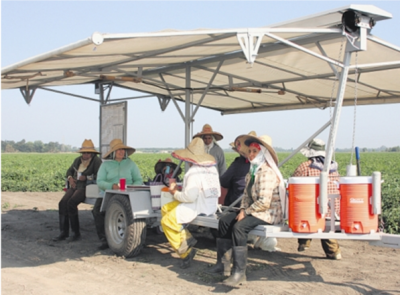Tuesday, July 6, 2021
Heat Illness
Understanding the Heat Illness Prevention Regulations
As we start our summer months and temperatures continue to rise it is important to understand not only the precautions to take to keep employees safe while working in the heat, but also the elements of compliance. According to the Division of Occupational Safety and Health (Cal/OSHA), their most frequently cited violations in agriculture under the Heat Illness Prevention Standard are failure to have a heat illness prevention plan in the field, a lack of heat illness prevention training, and a failure to provide adequate shade and water. If that’s the case, it begs the question of what exactly does the standard require?
#1 Heat Illness Prevention Plan:
A company must have a written Heat Illness Prevention Plan with the following elements, and include specific details as to how you will ensure that the provisions are met:
- The designated person(s) that have the authority and responsibility for implementing the plan in the field.
- Procedures for providing sufficient water.
- Procedures for providing access to shade.
- High-heat procedures.
- Emergency response procedures.
- Don’t forget your lone workers (e.g. irrigators).
- Acclimatization methods and procedures.
The plan needs to be in English and also the language understood by the majority of the employees. The plan must be located at the worksite and accessible to employees.
#2 Heat Illness Prevention Training:
Employee training needs to be done before an employee begins a shift which could result in the risk of heat illness. For a complete list of required employee and supervisor training topics, please visit www.dir.ca.gov/dosh/heatillnessinfo

Training must include the different types of heat illness, the common signs and symptoms of heat illness, and appropriate first aid and emergency responses to the different types of heat illness.
#3 Adequate Shade and Water:
Shade
Shade needs to available when the temperature exceeds 80-degrees Fahrenheit. Shade can consist of natural or artificial means that does not expose employees to unsafe or unhealthy conditions and that does not deter or discourage access or use. The amount of shade present shall be at least enough to accommodate the number of employees on recovery or rest periods, so that they can sit in a normal posture fully in the shade without having to be in physical contact with each other. The shade shall be located as close as practicable to the areas where employees are working. Shade also needs to be available, even when the temperature does not exceed 80-degrees Fahrenheit, upon employee request.

The amount of shade present shall be at least enough to accommodate the number of employees on recovery or rest periods, so that they can sit in a normal posture fully in the shade without having to be in physical contact with each other.
Water
Employees shall have access to potable drinking water. It must be fresh, pure, suitably cool, and provided to employees free of charge. The water shall be located as close as practicable to the areas where employees are working. Where drinking water is not plumbed or otherwise continuously supplied, it shall be provided in a sufficient quantity at the beginning of the work shift to provide one quart per employee per hour for drinking for the entire shift.
For more information about heat illness prevention, worker safety, human resources, labor relations, or pesticide safety, please visit www.agsafe.org, contact AgSafe at (209) 526-4400 or via email at safeinfo@agsafe.org.
Source: AgSafe

